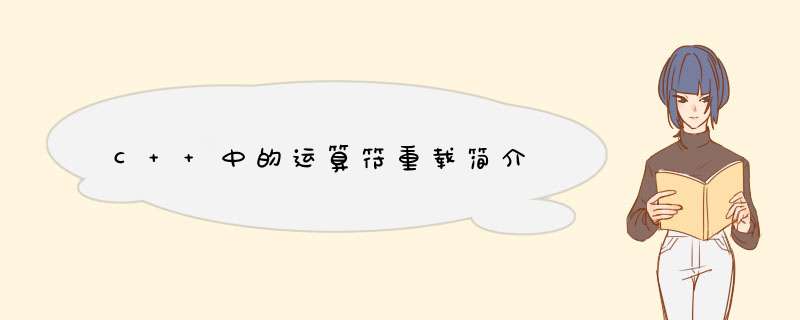
所谓运算符重载,本质上也是对函数重载。
根据不同形参类型调用首部相同的不同函数。
这是静态多态的表现。
2.运算符指的诸如:
+,-,*,/,[],()等。它们本质上是函数。
运算符重载一般有成员函数和友元函数两种实现方式。
基本语法是:operator运算符(形参列表)
E
g
1
:
Eg1:
Eg1:重载+实现自定义整数类型Myint的数据成员x的加法。
#include
E
g
2
:
Eg2:
Eg2:重载
“
+
+
”
“++”
“++”运算符实现自定义整数类型myint的前置递增运算符。
//重载++
myint& operator++()
{
x++;
return *this;
}
注意
1.前置递增必须返回引用。
2.为了以示后置递增与前置递增的区别,后置递增需要增加占位记号。
myint operator++(int)
{
myint temp = *this;
x++;
return temp;
}
E
g
3
:
Eg3:
Eg3:重载myint的=运算符实现连等。
myint& operator=(myint& temp)
{
this->x = temp.x;
return *this;
}
注意
为实现连等,必须返回引用
可以在主函数调用如下:
int main()
{
myint a(1), b(2);
myint c(3);
c = b = a;
c.show();
return 0;
}
此时输出 x = 1 x=1 x=1
既然是成员函数,除了直接用运算符调用以外,也可以使用:
a.operator=(b);
E
g
4
:
Eg4:
Eg4:采用外部函数方法,实现
E
g
1
Eg1
Eg1中的+的重载。
#include注意
外部函数无法直接访问类内数据,要设置为友元函数,但会破坏封装性。
另外,外部函数实现重载后也可以采用函数调用的方法,如:
myint a(1), b(1), c(5);
c = operator+(a, b);
E
g
4
:
Eg4:
Eg4:重载<<运算符,打印myint类型数据;要求:可以连打印多个数据。
分析:
<<本质上是一个函数,当我们使用如下语句:
cout << x << endl;
本质上我们是通过对象cout调用了operatpor<<这个函数。
如果要实现连续打印,调用结束后必然还是要返回cout这个对象。
注意,cout是属于ostream类的,且全局只有这一个对象。
因此,返回值类型必须是ostream类的引用且形参中也必须如此。
如果采用成员函数实现,那么应该写为:
ostream& operator<<(ostream& cout)
{
cout << x;
return cout;
}
这时,根据调用的顺序应该是:
int main()
{
myint a(1);
a << cout << endl;
//cout << a;错误
return 0;
}
显然不是我们期望的结果。
当然了,我们也无法在cout中重载<<,因为这已经封装好了。
因此,重载<<运算符,只能采用友元函数,如下:
#include值得注意的是,此处的ostream& cout不能加const修饰。
因为输出会先进入到ostream流,再到屏幕显示,也就是会改变其属性。
因此不能加const。
C + + C++ C++规定,以下运算符只能通过成员函数来重载。
| 运算符 | 含义 |
|---|---|
= | 赋值运算符 |
() | 函数调用运算符 |
[] | 下标运算符 |
-> | 指针访问类成员的运算符 |
对=无法重载为友元函数进行解释如下:
示例如下代码,
#include输出为:
这说明语句a=20会默认去调用与右值匹配的构造函数,也就是转为了a(20)
如果我们在成员函数内重载了=
#include输出为:
可以看出,此时根本没有调用与右值匹配的构造函数。
而如果我们在外部实现重载=,这个函数是友元函数,它并不属于类。
当程序执行到a=20,类中若有匹配的构造函数,且外部友元函数也匹配,这时候就会出现二义性。无法判断应该调用哪一个函数。
另外,对于[]举例说明:
假设我们采用采用友元函数实现,并如下设置形参顺序:
char operator[](int idx, mys& Mys)
那么我们显然调用时要写成下面这样的语句:
char temp = 1[Mys];
这显然是不合适的,因此 C + + C++ C++规定其重载只能用成员函数实现。
(3)无法重载的运算符| 运算符 | 含义 |
|---|---|
: | 成员运算符 |
.* | 成员指针运算符 |
:: | 作用域解析运算符 |
?:: | 三目运算符 |
sizeof | 求字节运算符 |
const_cast | 强制类型转换运算符 |
欢迎分享,转载请注明来源:内存溢出

 微信扫一扫
微信扫一扫
 支付宝扫一扫
支付宝扫一扫
评论列表(0条)